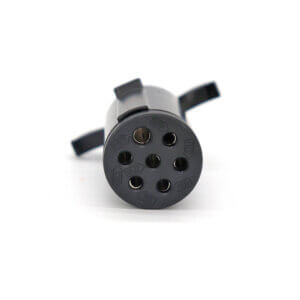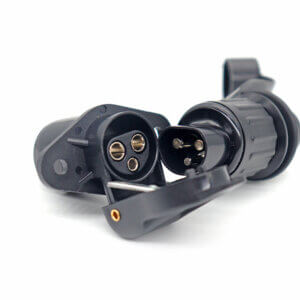Hey truckers, ever been stuck with a truck full of goods breaking down on the road, only to find out after ages it’s not the engine but the trailer wiring? Turns out, 90% of newbies overlook the “Pin count” difference when picking trailer wires – choosing the wrong 7-Pin or 3-Pin can mess up your brakes, lights, and even cause accidents. This article breaks down the key differences between 7-Pin and 3-Pin wires in plain English, so you can pick the right one for your haul and avoid getting stranded.
First, understand what “Pin Number” means? Why can’t logistics vehicles randomly choose the towing cables?
What is 3-Pin/7-Pin Trailer Wire? Understand the Structure with One Picture


In simple terms, “Pin” refers to the metal contacts in the trailer wire connector, which are responsible for transmitting various types of electrical signals (such as brake, turn signal, and reverse light signals, etc.).
The 3-Pin trailer cable has only 3 metal contacts. Its core function is “basic signal transmission with simplicity”, and it only supports 3 core requirements: “left and right turn signals + brake lights”. It is suitable for ultra-lightweight logistics trailers (such as micro trailers with a load of 500kg or less, commonly seen in small package delivery and short-distance fresh food transportation within cities).
Adding 4 more contacts on the 3-pin base, in addition to the basic lighting signal, it can also transmit 3 types of critical signals, fully compatible with medium and heavy logistics scenarios:
Reverse light signal: When towing a vehicle with a reversing light, the reversing light can be simultaneously illuminated, making night driving or reversing in a warehouse safer;
12V power signal: It can charge the trailer battery (for example, for trailers with refrigeration functions to prevent refrigeration equipment from losing power and causing the goods to deteriorate);
Brake controller signal: When connecting a heavy trailer (with a load of ≥ 1 ton), it can synchronously control the trailer’s brakes to avoid the danger of “the front of the vehicle braking while the trailer rushes out”.
Making the wrong choice between 3-Pin and 7-Pin will result in 3 fatal consequences.
Function deficiency: Installing 3-Pin wires on micro trailers with “small lights” (nighttime outline lights) will cause the small lights to fail to illuminate, making it easy for the rear vehicle to overlook during night driving and increasing the risk of rear-end collisions;
Load compatibility failure: Connecting trailers with a load capacity of over 1 ton to 3-Pin wires will result in the trailer “stalling” during braking, potentially causing tire wear or even a tire blowout;
Equipment damage: Forcefully supplying power to trailers that require 12V power (such as small trailers with refrigeration functions) using 3-Pin wires will cause overloading of the circuit, resulting in the burnout of the trailer’s refrigeration module.
| Comparison dimension | 3-pin trailer cable | 7-pin trailer wire |
| Number of metal contacts | 3 | 7 |
| core function | Left and right turn signals, brake lights | 3-Pin interface includes all functions + reversing light, 12V power supply, and brake controller |
| Compatible logistics vehicle model | Compatible logistics vehicle ultra-lightweight micro trailer (with a load capacity of ≤ 500kg) | Heavy-duty trailers (with a load capacity of ≥ 1 ton, such as container trailers) |
| applicable scene | Urban short-distance delivery (express delivery, fresh food) | Urban short-distance delivery (express delivery, cross-city long-distance heavy-load transportation of fresh goods (furniture, building materials)) |
| Recommended logistics scenarios | Electric micro-truck trailers, three-wheeler trailers | semi-trailer trucks, heavy-duty logistics trailers |
Novices can also choose the right 3-Pin/7-Pin
- Check the “Load Capacity + Function” of the trailer:
If the trailer only requires “turning + braking” signals (without small lights or power requirements), and the load capacity is ≤ 500kg (such as a small delivery trailer used for deliveries in the city), choose 3-Pin; - If the trailer has small lights, reversing lights, or the load capacity is ≥ 1 ton, it must be selected as 7-Pin (such as a heavy-duty trailer used for long-distance transportation of furniture);
Check the original vehicle interface:
If the original vehicle has a 3-Pin interface, preferentially choose the 3-Pin cable
If the original vehicle has a 7-Pin interface, you can directly choose the 7-Pin cable. If you need to connect an ultra-light trailer, you can also pair it with the “3-to-7-Pin Adapter”
Is your logistics vehicle for short-distance urban routes or long-distance heavy-load transportation? Please send the vehicle model and load capacity to WhatsApp (+86-18321959316), and we will help you determine whether to choose 3-Pin or 7-Pin trailer cables for free.
